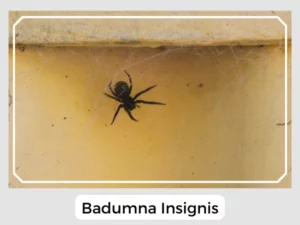Badumna spiders are special critters found in places like Australia, Asia, and America. They’re known as intertidal spiders and are super important in the places they live, even if they’re not always in the spotlight. In this blog, we’ll dive into some neat facts about these amazing spiders.
The eggs of most of the species of this genus are white and round.
The juveniles are also small, with most of them dispersing from their mother on maturation.
Spiders of this genus weave webs to trap their prey, though the pattern differs from one species to the other. The black house spider (Badumna insignis) makes a messy web with a funnel-shaped retreat situated at the center or corner of their mesh.
Yes, Badumna Spiders do have venom. They use it to catch the bugs they munch on. But for people, it’s usually not too strong.
Badumna Spiders can bite, but they’re mostly quiet critters. They’ll only bite if they feel really cornered or scared.
Badumna spiders are vital in the ecosystem, controlling insect populations, benefiting plants, and preventing pest overpopulation.
Natural Predator: Although the Badumna spiders are adept hunters, they’re not at the top of the food chain. They often fall prey to larger predators, such as birds, wasps, and bigger spiders. These checks and balances ensure that no one species dominates and maintains the ecological equilibrium.
Prey-Predator Dynamics: Badumna spiders trap bees, ants, and wasps with unique webs, playing a key role in controlling pest populations.
Relationship with Humans: Badumna spiders, often found in human structures and trees, are beneficial cohabitants. They pose no venomous threat to humans and help reduce pests like flies and mosquitoes, indirectly promoting healthier living conditions.
| Lifespan | Approximately two years |
| Distribution | Continents of Asia, America, and Australia |
| Habitat | Human structures and buildings, as well as rough-barked trees |
| Diet | Bees, butterflies, ants, flies, beetles and wasps |

In conclusion, by fostering a deeper understanding and appreciation for the Badumna spiders, we can better appreciate their role in our ecosystems and the invaluable services they provide, often unnoticed and uncredited.
Badumna spiders are special critters found in places like Australia, Asia, and America. They’re known as intertidal spiders and are super important in the places they live, even if they’re not always in the spotlight. In this blog, we’ll dive into some neat facts about these amazing spiders.
The eggs of most of the species of this genus are white and round.
The juveniles are also small, with most of them dispersing from their mother on maturation.
Spiders of this genus weave webs to trap their prey, though the pattern differs from one species to the other. The black house spider (Badumna insignis) makes a messy web with a funnel-shaped retreat situated at the center or corner of their mesh.
Yes, Badumna Spiders do have venom. They use it to catch the bugs they munch on. But for people, it’s usually not too strong.
Badumna Spiders can bite, but they’re mostly quiet critters. They’ll only bite if they feel really cornered or scared.
Badumna spiders are vital in the ecosystem, controlling insect populations, benefiting plants, and preventing pest overpopulation.
Natural Predator: Although the Badumna spiders are adept hunters, they’re not at the top of the food chain. They often fall prey to larger predators, such as birds, wasps, and bigger spiders. These checks and balances ensure that no one species dominates and maintains the ecological equilibrium.
Prey-Predator Dynamics: Badumna spiders trap bees, ants, and wasps with unique webs, playing a key role in controlling pest populations.
Relationship with Humans: Badumna spiders, often found in human structures and trees, are beneficial cohabitants. They pose no venomous threat to humans and help reduce pests like flies and mosquitoes, indirectly promoting healthier living conditions.
| Lifespan | Approximately two years |
| Distribution | Continents of Asia, America, and Australia |
| Habitat | Human structures and buildings, as well as rough-barked trees |
| Diet | Bees, butterflies, ants, flies, beetles and wasps |

In conclusion, by fostering a deeper understanding and appreciation for the Badumna spiders, we can better appreciate their role in our ecosystems and the invaluable services they provide, often unnoticed and uncredited.